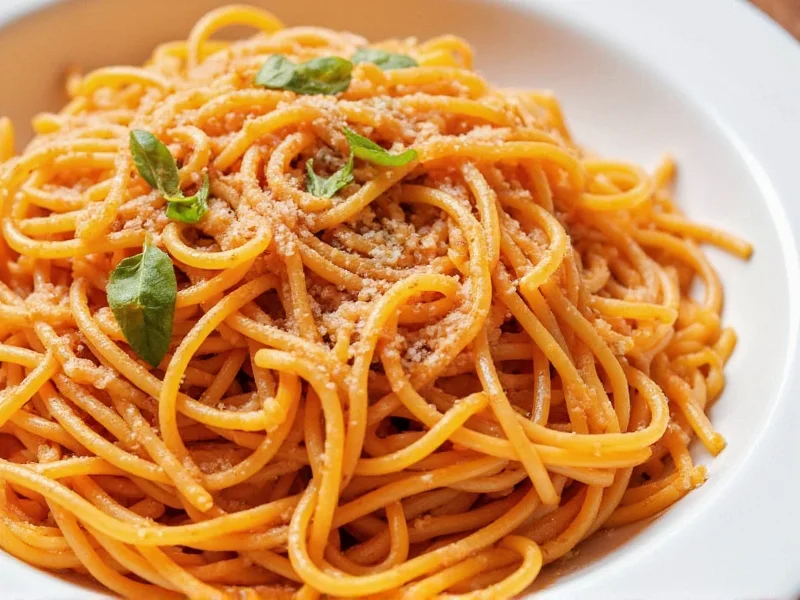The best homemade spaghetti seasoning recipe combines 2 tablespoons dried basil, 2 tablespoons dried oregano, 1 tablespoon garlic powder, 1 tablespoon onion powder, 2 teaspoons dried parsley, 1 teaspoon dried thyme, 1 teaspoon red pepper flakes, and 1 teaspoon black pepper. Mix all ingredients thoroughly and store in an airtight container. Use 2-3 tablespoons per pound of ground beef or per 24 ounces of tomato sauce for perfect Italian flavor every time.
Why Make Your Own Spaghetti Seasoning Blend
Creating your own spaghetti seasoning recipe gives you complete control over flavor profiles and ingredient quality. Unlike store-bought versions that often contain fillers, anti-caking agents, and excessive sodium, a homemade spaghetti seasoning blend delivers fresher, more vibrant flavors while allowing customization to your personal taste preferences. This simple dry spaghetti seasoning recipe costs pennies per batch compared to commercial alternatives and ensures you know exactly what goes into your family's meals.
Essential Components of Perfect Spaghetti Seasoning
Understanding each ingredient's role helps you create a balanced spaghetti seasoning without salt or with modifications that suit dietary needs. The foundation of any authentic spaghetti seasoning blend ingredients includes:
- Basil - Provides sweet, slightly peppery notes
- Oregano - Delivers earthy, robust Italian flavor
- Garlic powder - Adds savory depth without burning
- Onion powder - Contributes subtle sweetness
- Parsley - Brightens the overall flavor profile
- Thyme - Offers subtle floral notes
- Red pepper flakes - Provides gentle heat
- Black pepper - Adds complexity and warmth
Step-by-Step Spaghetti Seasoning Recipe
Follow this precise spaghetti seasoning measurements guide for restaurant-quality results every time:
- Gather 2 tablespoons dried basil, 2 tablespoons dried oregano, 1 tablespoon garlic powder, 1 tablespoon onion powder, 2 teaspoons dried parsley, 1 teaspoon dried thyme, 1 teaspoon red pepper flakes, and 1 teaspoon freshly ground black pepper
- Place all ingredients in a small bowl
- Whisk thoroughly for 1-2 minutes to ensure even distribution
- Transfer to an airtight container immediately to preserve freshness
- Label with date and "Spaghetti Seasoning" for easy identification
Customizing Your Homemade Spaghetti Seasoning
One major advantage of making your own spaghetti seasoning from scratch is the ability to tailor flavors. Consider these popular variations:
| Flavor Profile | Modification | Best For |
|---|---|---|
| Mild Family-Friendly | Reduce red pepper flakes to 1/2 teaspoon | Kids' meals, sensitive palates |
| Robust Italian | Add 1/2 teaspoon marjoram and 1/4 teaspoon fennel seed | Meat sauces, hearty dishes |
| Low-Sodium | Omit salt completely (recipe is naturally salt-free) | Heart-healthy diets |
| Lemon-Infused | Add 1 teaspoon dried lemon zest | Fish-based pasta dishes |
Proper Usage and Storage Techniques
For optimal results with your spaghetti seasoning blend, follow these professional tips:
When cooking ground meat for spaghetti sauce, add 2-3 tablespoons of seasoning per pound of meat during the last 5 minutes of browning. For tomato-based sauces, incorporate 2 tablespoons per 24 ounces of sauce and simmer for at least 20 minutes to allow flavors to meld. Never add the seasoning blend directly to boiling liquid, as this diminishes flavor complexity.
Store your homemade spaghetti seasoning in a dark glass jar with an airtight lid away from heat and light. Properly stored spaghetti seasoning storage tips ensure maximum freshness for up to 6 months. Avoid storing in plastic containers, which can absorb flavors and odors. For extended shelf life, keep in the refrigerator or freezer without compromising texture.
Troubleshooting Common Issues
If your spaghetti seasoning recipe turns out too strong, balance flavors by adding more tomato base or a pinch of sugar. For bland seasoning, gradually add more oregano and garlic powder 1/4 teaspoon at a time. If clumping occurs (common in humid environments), add 1-2 uncooked white rice grains to the container to absorb excess moisture without affecting flavor.
Maximizing Flavor Potential
For the most vibrant spaghetti seasoning without salt, toast whole dried herbs briefly in a dry skillet over low heat before grinding. This technique releases essential oils and intensifies flavor without adding calories or sodium. When using your homemade blend, always add it to hot oil or fat first to bloom the flavors before incorporating liquids - this professional chef technique makes a noticeable difference in final dish quality.
Frequently Asked Questions
How much spaghetti seasoning should I use per pound of meat?
Use 2-3 tablespoons of homemade spaghetti seasoning per pound of ground meat. Add it during the last 5 minutes of browning to allow flavors to incorporate without burning the delicate herbs.
Can I substitute fresh herbs for dried in this spaghetti seasoning recipe?
While fresh herbs work well in finished dishes, they're not suitable for dry spaghetti seasoning blends. Dried herbs have concentrated flavor and proper moisture content for long-term storage. Use the 3:1 fresh-to-dried ratio only when adding herbs directly to sauces, not in the seasoning mix itself.
Does homemade spaghetti seasoning need salt?
This authentic spaghetti seasoning recipe is intentionally salt-free, allowing you to control sodium levels based on dietary needs and other ingredients. Most tomato sauces and cheeses already contain sufficient salt, so adding it to the seasoning blend often results in oversalted final dishes.
How long does homemade spaghetti seasoning last?
Properly stored in an airtight container away from light and heat, homemade spaghetti seasoning maintains peak flavor for 6 months. After this period, it remains safe to use but gradually loses potency. For extended freshness, store in the refrigerator (8-10 months) or freezer (up to 1 year).
Can I use this spaghetti seasoning blend for other Italian dishes?
Absolutely! This versatile spaghetti seasoning from scratch works equally well in meatloaf, pizza sauce, roasted vegetables, and as a rub for chicken or fish. The balanced flavor profile makes it an excellent Italian seasoning substitute in virtually any recipe calling for Italian herbs.











 浙公网安备
33010002000092号
浙公网安备
33010002000092号 浙B2-20120091-4
浙B2-20120091-4